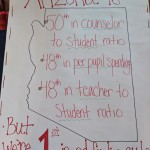I shamed a student once. She was kind, high performing, never got in trouble, participated positively in class activities, and had a good sense of humor. She started to ask something in what I thought was a sarcastic tone, and as if no middle school student were ever sarcastic (heck, as if no middle school student had been sarcastic that period), I unloaded on her. She protested that she wasn’t trying to be sarcastic, but I piled on. I bullied her.
I hope I never forget what it felt like the moment I realized I broke her.
I tried to recoup and get the lesson back on track but had to stop and apologize to her in front of the class saying I didn’t know what got into me. Later, when students were working independently I told her privately again that it was all my fault and I was sorry. At the end of class, as she walked by me, I told her I was embarrassed.
I called her mom and let her know what had happened and how badly I felt. She thanked me and said everyone’s been there. I also told the assistant principal, a couple of colleagues, and some friends. Everyone said that no one is perfect, that everyone loses it sooner or later. And that’s true.
But how did it help the girl?
In a sermon called The Future Can Change the Past, Rabbi Harold Kushner analyzes guilt and apologies and introduces the word teshuva. In teshuva, roughly translated as repentance, and literally translated as return, you go beyond apologizing for what you did and promising not to repeat it. You confront yourself as person who could hurt another and say you don’t want to be that person any more.
In his explanation, Kushner refers to Carl Jung’s “Shadow,” which is everyone’s dark side made up of: “…all the parts of our personality that we are embarrassed by, the dark side of us, the habits that we wish were not there.” We avoid facing them but, like our shadow, they follow us wherever we go. Teshuva, then, is the “radical surgical procedure for getting rid of our shadow.”
My teshuva has included telling (confessing?) to various people how I had bullied an innocent child, meeting with her and the counselor (at her request), and attending to the Christian (my faith) process of propitiation. All that put my shadow in front of me, and I’m not afraid to face it.
But how did any of that help the girl?









